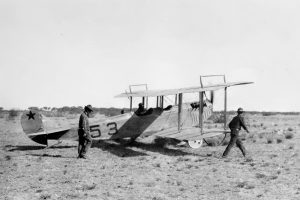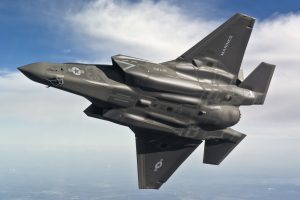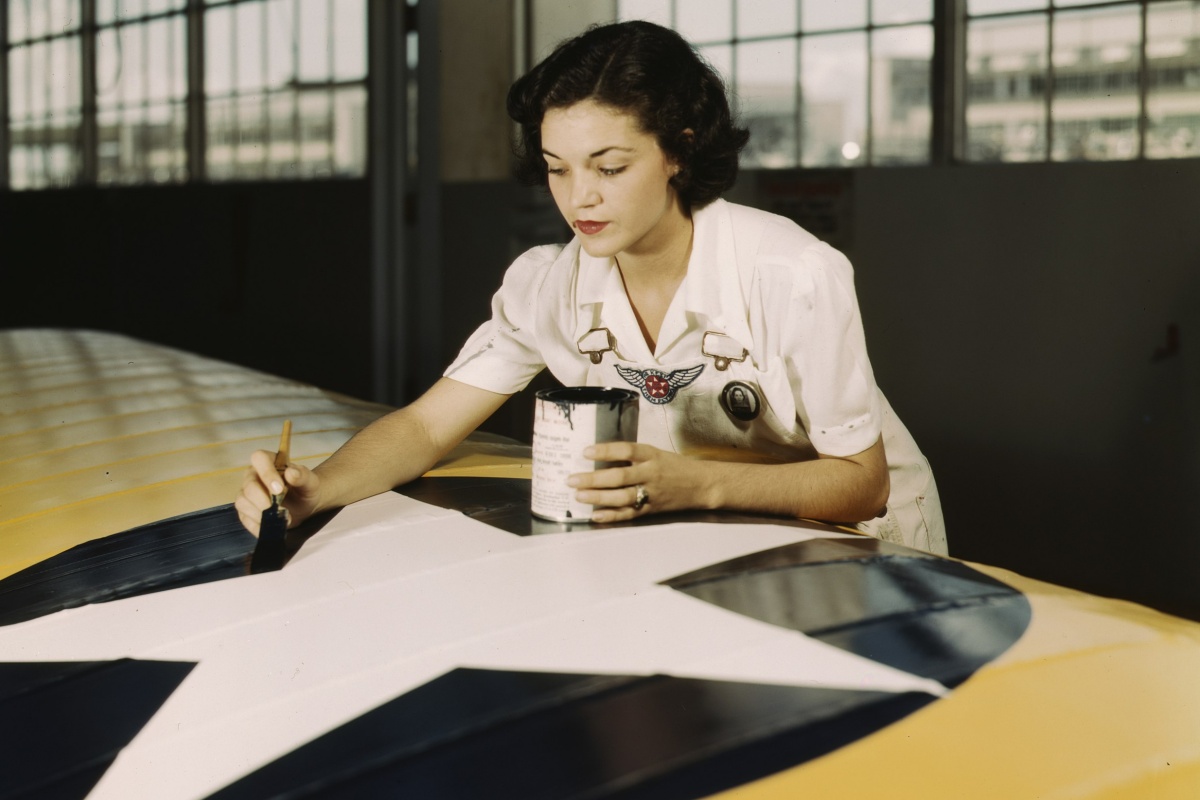In today’s final installment of the trilogy on the history of the military roundel, we look at the evolution of the insignia of the fourth most famous user, the US Air Force. The development of this roundel over time is probably the most complicated of all the four main operators, but it is all the more interesting, and there are several interesting uniques in its history.
From reconnaissance operations to the interwar period
 Although the first predecessor of this component of the armed forces was created already in August 1907, the initial distinguishing marks did not appear on the airplanes until nine years later during the so-called Mexican expedition. For liaison and reconnaissance purposes, the 1st Aero Squadron, equipped at the time with Curtiss JN-3 Jenny aircraft, was included in these expeditionary forces. And it was on these machines that the American insignia appeared for the first time on March 19, 1916. It was a red or, in rarer cases, a blue star, painted exclusively on the turn signal. Almost a month later, the US Navy also started using its own form of roundel, which applied a blue anchor to the wings and rudders of its seaplanes.
Although the first predecessor of this component of the armed forces was created already in August 1907, the initial distinguishing marks did not appear on the airplanes until nine years later during the so-called Mexican expedition. For liaison and reconnaissance purposes, the 1st Aero Squadron, equipped at the time with Curtiss JN-3 Jenny aircraft, was included in these expeditionary forces. And it was on these machines that the American insignia appeared for the first time on March 19, 1916. It was a red or, in rarer cases, a blue star, painted exclusively on the turn signal. Almost a month later, the US Navy also started using its own form of roundel, which applied a blue anchor to the wings and rudders of its seaplanes.
After the entry of the United States of America into World War I, all branches of the military began to use a roundel in the form of a white five-pointed star with a red circle in its center on a dark blue circular background as large as the pentagram itself, starting on May 19, 1917. In August 1919, the colors were adjusted to current standards and the central circle slightly reduced by about ⅓ of its diameter.
In February 1918, the United States Army Air Service (USAAS) introduced a lesser-known insignia consisting of white-blue-red circles running from the center to the edge in order to align with the European allies. It was applied on both sides of the fuselage (sometimes also on the undercarriage wheels) and on the upper and lower sides of the wings, again complemented by the tricolor on the rudder, this time always with a red stripe forward. The order of colors was then identical to the roundel of the former Imperial Russian Air Service, with the only difference being that the American emblem had a significantly smaller central white circle. Although these are very similar insignia, there is no connection between the USAAS insignia and the insignia of this or any other armed services. The only meaning of using this kind of coat of arms was to unify the type of coat of arms of the Allies of the Treaty while preserving the order of colors of the national identity.
Little known uniques
Between 1918-1922, a unique circular roundel was used by the US Navy with a red eagle sitting on top of it and an anchor of the same color placed diagonally from right to left behind the white-blue-red insignia, very similar in appearance to the official USMC insignia. This beautifully executed Navy insignia was placed on the sides of the fuselage only, with the standard insignia of the time on the wings and rudder. Another rare insignia was the Civil Air Patrol insignia used only from December 1941 to July 1946. It was a white triangle with a red three-bladed propeller in its center, again on a blue circular background. Fearing confusion with the Japanese Hinomaru circle, the silhouette of the propeller began to be gradually painted white during the Pacific War.
World War II
 Less than a year before the entry of the United States of America into the Second World War, specifically on February 26, 1941, the US Army Air Corps (USAAC) began using a new method of installing the rodnel on its machines. The change consisted in the fact that the insignia was painted only on the upper part of the left and lower part of the right wing. This modification had two reasons, firstly to make it easier to recognize the enemy and secondly to make it more difficult to hit the aircraft with enemy fire. The goal was to eliminate the optical effect of “sights”, which was created by painting white stars on both wings. Although the US Navy resisted this innovation and preferred the classic way, this asymmetric version was finally officially adopted on February 1, 1943.
Less than a year before the entry of the United States of America into the Second World War, specifically on February 26, 1941, the US Army Air Corps (USAAC) began using a new method of installing the rodnel on its machines. The change consisted in the fact that the insignia was painted only on the upper part of the left and lower part of the right wing. This modification had two reasons, firstly to make it easier to recognize the enemy and secondly to make it more difficult to hit the aircraft with enemy fire. The goal was to eliminate the optical effect of “sights”, which was created by painting white stars on both wings. Although the US Navy resisted this innovation and preferred the classic way, this asymmetric version was finally officially adopted on February 1, 1943.
Following the conversion of the USAAC to the United States Army Air Force (USAAF) and the subsequent attack on Pearl Harbor, it was believed that the central red circle could be mistaken for the Japanese Hinomaru emblem from a distance and was therefore removed from the roundel in May 1942. During November of that year, US forces took part in Operation Torch, and for this purpose an orthochromatic yellow ring of unspecified thickness was temporarily added to the outside of the roundel to reduce the number of incidents where the Americans shot down unknown British aircraft with a similar yellow outline on the insignia (e.g. type C. 1). However, this solution did not bring the desired result, because the unintentional downing of allied aircraft, including our own, continued to occur.
The US government therefore launched a study which found that the color itself, which is not visible from a distance anyway, is not the problem, but the shape of the roundel itself. After testing several variations, including an elongated emblem with two stars (all with a red outline), it was finally decided to use white stripes on the sides of the current insignia. Although this form became official as early as June 1943, there were various objections to the use of the red outline and at least one squadron refused to use it on their machines, leading to the installation of bare white stripes on the existing star roundel. For this reason, in September of the same year, the red outline color was replaced by blue, which corresponded to the round base of the white star in its shade.
 The following year, this blue outline was omitted on US Navy aircraft, because it either disappeared on the existing color (midnight blue) of the aircraft or it was already supplied from the factory that way and so only the white part of the roundel was visible. During the Pacific War, some British machines in service with the British Pacific Fleet and the Royal New Zealand Air Force (RNZAF) also had white stripes (so-called Lend Lease) without a central red circle as a more or less universal symbol of Allied aircraft. The reason was the same as for the United States, to eliminate the confusion of the emblem with the Japanese Hinomaru and the unwanted shooting down of allied aircraft.
The following year, this blue outline was omitted on US Navy aircraft, because it either disappeared on the existing color (midnight blue) of the aircraft or it was already supplied from the factory that way and so only the white part of the roundel was visible. During the Pacific War, some British machines in service with the British Pacific Fleet and the Royal New Zealand Air Force (RNZAF) also had white stripes (so-called Lend Lease) without a central red circle as a more or less universal symbol of Allied aircraft. The reason was the same as for the United States, to eliminate the confusion of the emblem with the Japanese Hinomaru and the unwanted shooting down of allied aircraft.
From the Cold War to the present
 In January 1947, longitudinal dividing red stripes (one on each side) were added to the existing white stripes on both USN and USAAF aircraft, replacing the old center circle and restoring the presence of this national color on the aircraft insignia. In 1955, in order to unify the appearance and colors of the insignia, the USN recolored all roundels from midnight blue to a combination of light gray and white. In order to achieve low visibility, since the 1970s, the blue outline and red dividing stripes have been gradually removed and replaced with a tinted or gray color. Currently, almost all USAF aircraft use black or gray low visibility roundels. The full-color variant was limited to only a small number of machines without camouflage (e.g. E-3 or E-8).
In January 1947, longitudinal dividing red stripes (one on each side) were added to the existing white stripes on both USN and USAAF aircraft, replacing the old center circle and restoring the presence of this national color on the aircraft insignia. In 1955, in order to unify the appearance and colors of the insignia, the USN recolored all roundels from midnight blue to a combination of light gray and white. In order to achieve low visibility, since the 1970s, the blue outline and red dividing stripes have been gradually removed and replaced with a tinted or gray color. Currently, almost all USAF aircraft use black or gray low visibility roundels. The full-color variant was limited to only a small number of machines without camouflage (e.g. E-3 or E-8).
The United States Coast Guard (USCG) is the only one of the eight uniformed services of the United States that can and still uses a full-color version of the emblem. This is a kind of tradition that started at the beginning of April 1967, when a service mark (so-called racing stripe) was initially displayed on one of their machines. Another unique feature is the use of the white star with stripes also on the tail surfaces of the aircraft.
source:
https://en.wikipedia.org/wiki/Orthochromasia
https://en.wikipedia.org/wiki/Pancho_Villa_Expedition
https://en.wikipedia.org/wiki/United_States_military_aircraft_national_insignia








